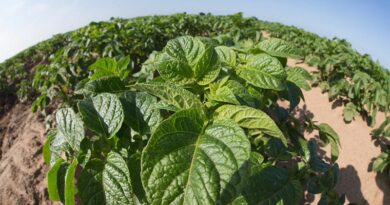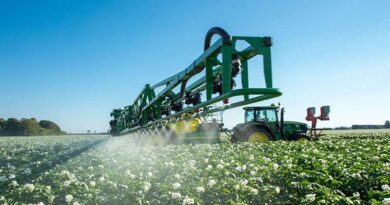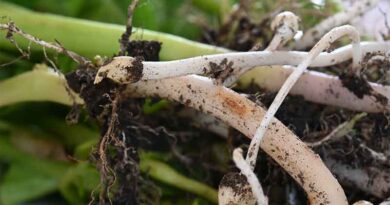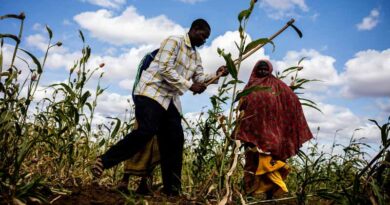Biostimulant Interest Hots Up
13 December 2020, UK: Bio stimulants are set to become a hot topic in all UK crop production, with potatoes among those with the most potential to gain.
Weather trends show a clear shift to higher temperatures, including prolonged periods of excessive peaks. And it’s crops with shorter growing seasons that can least afford any interruption in peak photosynthetic activity as a result of stress, warns Dave King, Head of Technical at Syngenta.
Also Read: Agdia Commercializes Rapid Molecular Assay for Detection of Potato Virus Y (PVY)
“Heat typifies the increasing stress potato crops are having to cope with. But there are a whole range of other abiotic influences adding increasing pressure, including drought, nutrition, solar radiation and air quality.
“That’s where we have seen biostimulants have a valuable role to mitigate the effects of stress,” he reported. “The greater the apparent influence of stress in limiting the crop’s potential, the higher the yield response recorded.”
Having completed field trials of the UK’s biggest study of biostimulant use in potatoes, Mr King highlighted initial analysis showed a correlation between the high temperatures experienced earlier in the season, and potential for yield responses where crops had been affected.

Using heat as an example of the increasing influence of abiotic stress on crop production, he highlights the latest Met Office State of the Climate report shows the UK is experiencing higher maximum temperatures and longer warm spells. All of the top ten warmest years since records began in 1884, have occurred since 2002.
Furthermore, hot summers are expected to become more common. Defined hot spells have increased from an average six days in length during records from 1961-1990, to over 18 days per year on average during the most recent decade.
The chance of experiencing summer temperatures as hot as any previous record years is now set at an unprecedented 12-25%.
Help shape the future of biostimulant research
Complete the UK biostimulant use in potatoes survey here
Research has shown the optimum root growth in potatoes occurs at soil temperatures of 15 to 20⁰C, with a fall off when temperatures exceed 20⁰C. The relatively shallow rooting of potatoes in the top 60 cm of soil profile, compared to cereals rooting to at least twice that depth, makes the crop more susceptible to temperature changes.

Furthermore, conditions for both haulm and stolon growth peak at around 25⁰C. Warmer soils have also been shown to limit tuber initiation and the numbers of tubers formed. The UK’s highest temperature of 38.7⁰C, recorded in the eastern counties in 2019, exemplifies future challenges for potato production.
For crops, or particularly varieties, evolved and selected to perform in relatively cool and lower light UK conditions, they could be ill-prepared for changing climatic conditions. Biostimulants could be crucial in helping those varieties better cope with challenges.
Syngenta has also seen differences in responses to biostimulant use in field trials, although Dave King acknowledged that sheer scale and complexity of the company’s latest research makes defining specific stress factor effects harder to pinpoint.
In the Syngenta trials it was crops that had been most impacted by the effects of stress, where untreated yields have been most severely limited, that showed the greatest response to biostimulant use.
That makes their use imperative as a way for more efficient use of available input resources, Mr King outlined. “Fertiliser use, for example, is under ever greater scrutiny for environmental and economic impacts, along with carbon footprinting and soil health. Where biostimulants can help develop root structures and plant physiological effects to get nutrients into the plant and better utilised it can improve yields from reduced inputs, and cut risk of environmental loss.”
Furthermore, with legislative pressure restricting the crop protection arsenal for agronomists, along with societal desire for reduced pesticide use, biostimulants offer the potential to achieve the best possible results of what is available, as well as opening opportunities new product development.
“Biostimulants and crop protection products are entirely complementary. We know that where plants are under stress they are more susceptible to infection by disease pathogens and the effects are more severe.
“Alleviating that barrier to plants’ natural health increases the opportunity for crop protection to work most effectively,” advised Mr King.
In potatoes, for example, the incidence of Alternaria is closely associated with a whole range of stress factors, including nutrient, heat and moisture, and with a clear link to varietal susceptibility. Timing of infection also has a significant implication for final yield effects. Biostimulants would offer the opportunity to alleviate some stress factors that could reduce risks of infection, which could prove especially valuable where crop protection options to manage Alternaria are set to be further limited by legislative withdrawal, he advocated.
Syngenta has publicly stated that as a company its future lies in reduced pesticide use per crop, but ensuring every application is made more effectively, to deliver better results from fewer inputs. Biostimulants are a key element for future sustainable agriculture and food production, it suggested.
Earlier this year the company has bought Valagro, a global market-leader in biostimulants and speciality nutrients in the biologicals market that is expected to double in size in the next five years.
The Group’s chief executive, Erik Fyrwald, highlighted the acquisition is fully in-line with Syngenta’s strategy to provide growers with additional complementary choices of products and technologies. He cited the move would enable growers to effectively and sustainably care for crops by managing resistance, enhancing soil health, reducing residues in crops, and addressing consumer demands.
“The investment also forms part of our $2 billion commitment to help farmers address the effects of climate change and improve agricultural sustainability as part of our Good Growth Plan,” outlined Eric Fyrwald.
The two companies were said to be eager to collaborate, share knowledge and build on each other’s capabilities.
As an agronomy tool, Dave King believes research needs to focus on results of using both biostimulants and crop protection together. “The more we understand about the science behind the biostimulants, the better growers and agronomists can make use of the benefits in different situations.”















